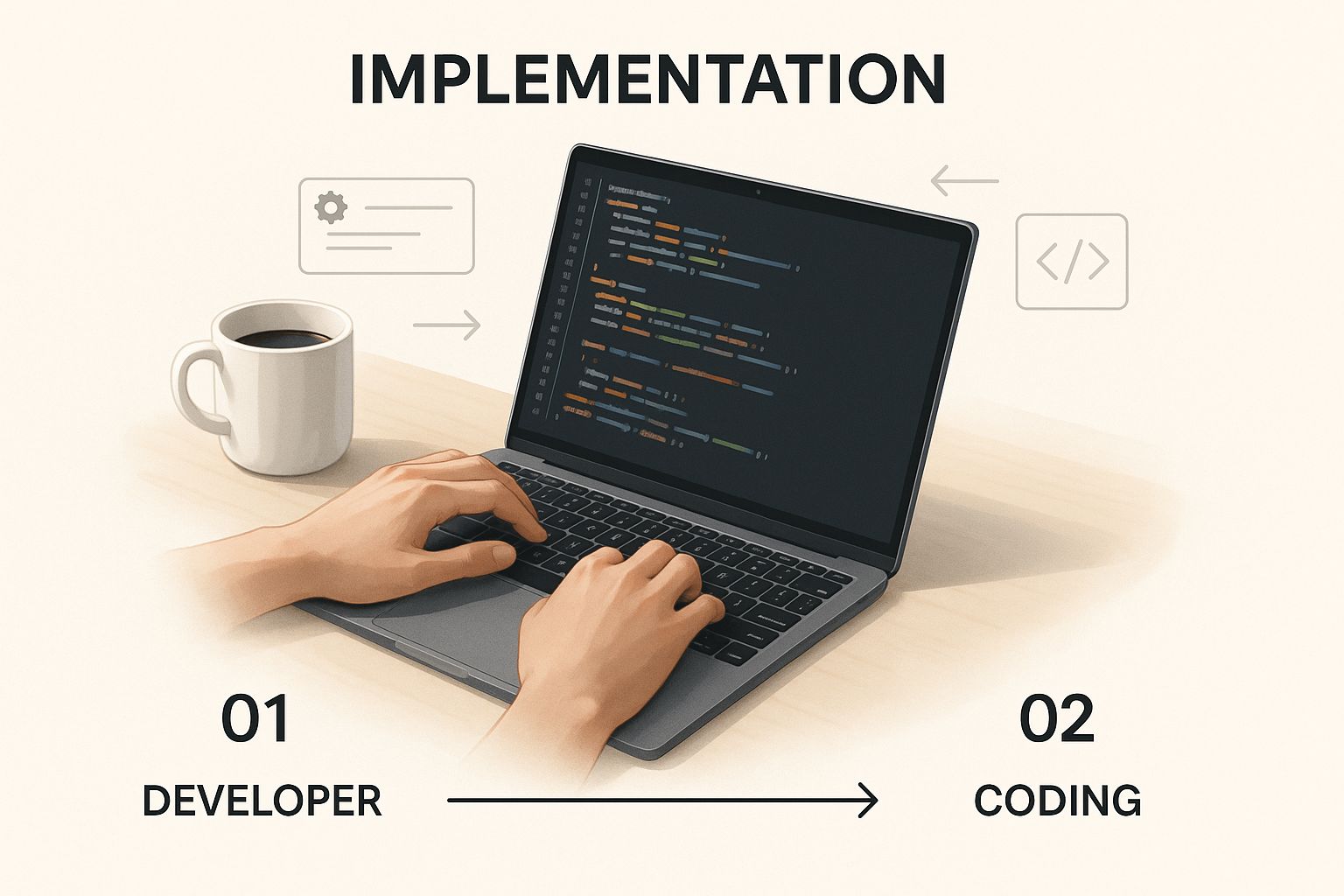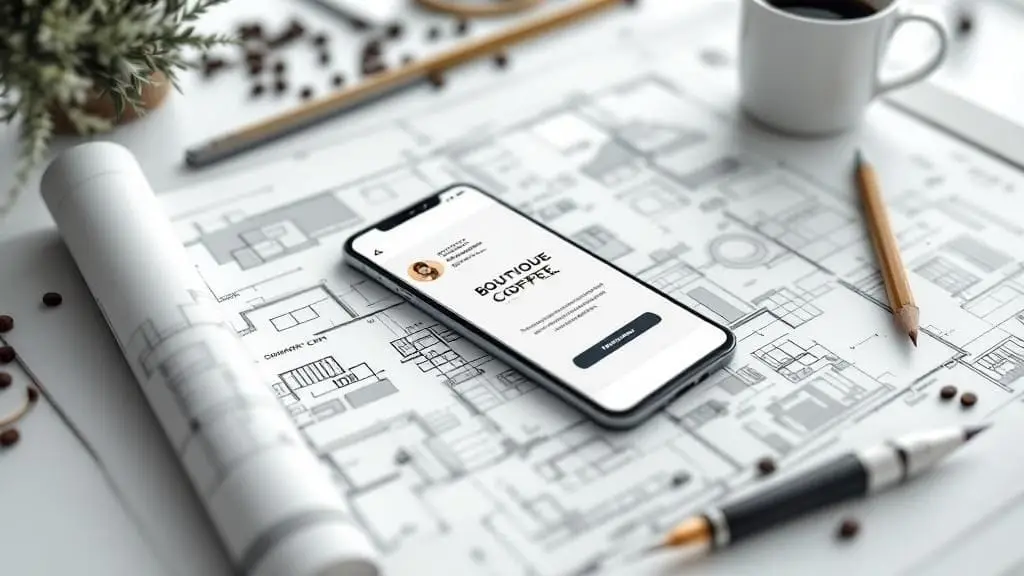To put it simply, a classic software development life cycle example is the journey of taking a new e-commerce application from a rough idea all the way to a live, functioning platform. It’s a structured path—planning, designing, coding, testing, and deploying—that brings order and quality to the entire process.
What Is The Software Development Life Cycle

Think of the Software Development Life Cycle (SDLC) as the master blueprint for building a house. You wouldn't just start pouring a concrete foundation without detailed architectural plans, right? In the same way, you can’t build reliable, high-quality software without a structured process to guide you. The SDLC is that strategic roadmap.
It provides a clear framework that turns a simple concept into a fully functional and market-ready product. This isn't about adding red tape; it's about taming complexity, controlling costs, and avoiding the kind of chaos that sinks so many unstructured projects. In fact, nearly half of C-suite executives admit that 30% or more of their software projects get delayed or go over budget, often because there’s no clear process in place.
Why a Structured Process Matters
Without a life cycle guiding development, teams can easily end up building the wrong product, blowing past deadlines, and delivering a buggy, frustrating user experience. The SDLC brings order to the chaos by breaking the massive task of software creation down into smaller, distinct phases. Each phase has its own specific goals and deliverables, ensuring every step builds logically on the last one.
This structured approach brings several huge benefits to the table:
- Clarity and Direction: Everyone, from the stakeholders signing the checks to the developers writing the code, understands the project goals and their role in reaching them.
- Risk Management: You can spot potential problems early on in the process, which makes them much easier and cheaper to fix.
- Improved Quality: With defined testing and review stages built-in, you can be confident the final product is stable, secure, and actually meets user expectations.
The Software Development Life Cycle provides the essential scaffolding for any project. It ensures that what is built not only functions correctly but also aligns perfectly with business objectives and user needs.
The concept itself has come a long way. Early models like Waterfall were strictly sequential, but modern approaches are far more flexible. It’s no surprise that over 70% of organizations now use Agile frameworks, which prioritize iterative development and constant feedback. You can explore this evolution further in our article on how ERP software can streamline operations.
Following an SDLC Example: Building an E-Commerce App
Theory is great, but let's make this real. To see how the SDLC works in practice, we'll walk through the entire process of building a mobile e-commerce app for a boutique coffee roaster. Let's call our fictional company "Roast & Go."
The business goal is straightforward: create an app for customers to browse, order, and subscribe to premium, freshly roasted coffee beans. This isn't just a coding exercise; it's about turning a business idea into a real product that brings in revenue and builds a loyal customer base.
Introducing The Key Players
No project is built in a vacuum. For Roast & Go to succeed, it needs a solid team. The key players are:
- The Business Owner: The coffee roaster with the vision and the business needs.
- The Development Team: A small, agile group of designers, developers, and a project manager tasked with bringing the app to life.
- Future Users: Coffee lovers who will expect a seamless and intuitive shopping experience on their phones.
This team will navigate the classic SDLC phases together, as shown in this diagram.
The image illustrates the flow perfectly—planning and design lead to development and testing, which then cycles into deployment and ongoing maintenance.
The success of the entire project boils down to one thing: translating the owner's vision into technical requirements the dev team can build, all while keeping the end user's needs front and center.
This high-level vision is our starting line. With a clear scenario established, we can now step through each SDLC phase and see how abstract concepts like "requirements gathering" and "deployment" actually play out when building a real product. Let's dive into the first phase, where the idea starts to become something more concrete.
Phase 1: Planning and Requirements Gathering
Every great piece of software starts long before the first line of code is ever written. It begins with a solid plan. For our "Roast & Go" coffee app, this initial phase is all about turning a cool idea into a detailed, actionable blueprint. This is where the team gets real and asks the big questions: What are we actually building? Why are we building it? And most importantly, can we even pull this off?
The whole process kicks off with some initial research and what’s called a feasibility study. The team digs into the market, checking out what competing coffee apps are doing and looking for gaps they can fill. They also have to be brutally honest about technical feasibility—do we have the right people and budget to build this?—and financial viability, making sure the potential payoff is worth the cost. This step is crucial for preventing the company from sinking time and money into an idea that's dead on arrival.
Once the project gets the green light, the focus shifts to the most critical part of this phase: figuring out exactly what needs to be built.
Defining What to Build
This isn't just about jotting down a list of features. It’s about getting into the heads of both the business owner and the future customers. To get this right, you have to use essential user research methods that give you real insight into what people actually need and want.
The "Roast & Go" team sits down with the business owner (the stakeholder) to understand their goals, like boosting online sales and creating a loyal customer base. From there, they create user stories to see the app through the eyes of its future customers. These are simple, powerful sentences that frame a feature from the user's point of view.
For our coffee app, a few user stories might look like this:
- As a busy professional, I want to save my favorite coffee order so I can reorder it with a single tap.
- As a coffee enthusiast, I want to read detailed tasting notes for each blend before I make a purchase.
- As a subscriber, I want to easily pause or change my monthly coffee subscription.
This meticulous planning directly feeds into the later stages, like coding and implementation.

Think of it this way: clear, well-defined requirements are the architectural drawings that guide the construction of the actual app.
All of this information—stakeholder goals, user stories, technical limits, and the project's scope—gets collected into one formal document called the Software Requirement Specification (SRS).
The SRS document is the single source of truth for the entire project. It’s basically a contract between the stakeholders and the development team, making sure everyone is on the same page and working toward the same finish line.
With this detailed blueprint in hand, the team has a clear path forward. It drastically reduces the risk of expensive misunderstandings down the road and lays the strong foundation needed to build the entire "Roast & Go" app.
Phase 2: Designing and Building The Application
With the detailed blueprint—the Software Requirement Specification (SRS)—in hand, the "Roast & Go" project is ready to move from abstract ideas to concrete reality. This is where the vision truly starts taking shape, first as a technical design and then as functional code. This part of our software development life cycle example is all about two deeply connected stages: Design and Development.
Think of the design phase like an architect drafting detailed construction plans before a single brick is laid. It’s not about writing code just yet. Instead, it's about making the big, foundational decisions that will dictate exactly how the app gets built.
Creating the Architectural Blueprint
The design process unfolds on two different levels. First up is the High-Level Design (HLD), which is the 30,000-foot view of the system’s architecture. For our "Roast & Go" app, this means choosing the core technologies that will power everything.
After a lot of discussion, the team settles on a modern tech stack that perfectly balances performance, the ability to scale up later, and development speed. This is a massive decision, as it sets the entire technical foundation for the application.
Technology Stack for the 'Roast & Go' E-Commerce App
Here's a quick look at the technologies the team decided on for each part of the "Roast & Go" app. This table breaks down not just the "what," but also the "why" behind each choice, which is crucial for building a solid architectural foundation.
| Component | Technology Choice | Reason for Selection |
|---|---|---|
| Mobile App (Frontend) | React Native | Allows for a single codebase for both iOS and Android, saving a ton of time and resources. |
| Backend API | Python (with Django) | Offers rapid development, a robust framework, and excellent scalability for e-commerce. |
| Database | PostgreSQL | A powerful, open-source database known for its reliability and ability to handle complex queries with ease. |
Making these high-level choices upfront ensures everyone is on the same page and working with a consistent, well-thought-out technical strategy.
Next, the team dives into the Low-Level Design (LLD). This is where they zoom in and map out all the finer details, like defining specific API endpoints (e.g., /login, /products) and designing the database schema. Getting this stage right is absolutely essential for creating a stable and maintainable application. You can learn more about the principles of effective web design and layout in our detailed guide.
Turning Designs into Working Code
Once the design is locked in and approved, the development phase officially kicks off. This is where the programmers finally get their hands dirty and start writing the code that brings "Roast & Go" to life. The global developer pool is exploding, with some estimates suggesting it will hit 30 million by 2025. To keep up, over 80% of development teams now use AI-powered tools to boost their productivity. For more insights, you can check out some of the latest software development trends.
The "Roast & Go" team follows an Agile methodology, meaning they build the app in small, digestible chunks called sprints. Each sprint usually lasts two weeks and has a clear goal: deliver a specific set of features from the SRS document.
A sprint-based approach is fantastic because it lets the team deliver value incrementally and adapt to changes on the fly. Instead of one massive "big bang" release at the end, the product evolves feature by feature, ensuring it always stays aligned with what the business actually needs.
For instance, the very first sprint might focus only on building the user authentication system—letting users sign up, log in, and reset their passwords. From there, subsequent sprints would tackle other key features one by one:
- Building out the product catalog display.
- Implementing the shopping cart functionality.
- Integrating a secure payment gateway.
This iterative cycle continues until every feature outlined in the requirements is fully built, coded, and ready to move on to the next critical phase: testing.
Phase 3: Testing and Deployment

With the “Roast & Go” app now built and functional, it's tempting to get it out the door immediately. But launching an untested product is like serving coffee made from unroasted beans—the experience will be bitter, and customers won't come back.
This is where the testing phase comes in. Think of it as the project's quality control checkpoint, a critical step in any serious software development life cycle example. It’s a multi-layered process designed to hunt down and squash every possible bug, glitch, and frustrating user experience issue before the app ever reaches a customer.
The Layers of Quality Assurance
Good testing isn’t just one big check. It’s a series of systematic inspections, each with a specific job. For the "Roast & Go" app, the process would break down something like this:
- Unit Testing: We start small. Developers test individual components in isolation, like making sure the login button actually tries to log you in or that the "add to cart" function works on its own.
- Integration Testing: Next, the team starts combining these individual pieces. Do they play nicely together? For example, when an item is added to the cart, does the subtotal on the checkout screen update correctly?
- System Testing: Now we look at the big picture. The entire app is tested from start to finish as one cohesive system. This mimics real-world use and verifies that everything works together exactly as laid out in the requirements.
This structured approach is designed to catch problems early. And in software, finding issues sooner is always cheaper and easier than fixing them later.
The reality is that typical software development projects require an average timeline of three to six months, and to prevent post-release failures, Testing and Quality Assurance (QA) costs have risen by 26%. Discover more insights about software development statistics from ManekTech.
The final hurdle before launch is User Acceptance Testing (UAT). This is where the coffee roaster’s owner gets their hands on the app. They'll use it just like a real customer would, confirming it meets their business needs and feels right. Only with their final sign-off can we move forward.
Going Live: Deployment
Once "Roast & Go" passes every test and gets the green light, it's time for the big show: Deployment. This is the moment the app moves from the controlled development environment to the live production servers where real customers can access it.
The team packages the application and submits it to the Apple App Store and Google Play Store for their review processes. Once approved, the app goes live.
Just like that, "Roast & Go" is officially available for coffee lovers to download. This successful launch marks the completion of the core development cycle, but the journey isn't over yet.
Phase 4: The Ongoing Maintenance Cycle
So, the "Roast & Go" app is live on the App Store. High-fives all around! But this isn't the finish line. Not even close. In reality, launch day is the start of the longest and arguably most critical phase in any software development life cycle example: ongoing maintenance.
This is where the app stops being a project and starts being a living, breathing service. The team's focus now shifts from building new things to supporting what's already out there. It’s all about keeping the app healthy, secure, and useful for coffee lovers everywhere.
Keeping the App Healthy and Relevant
Maintenance isn't just about squashing bugs when they pop up—though that's certainly part of it. It's a proactive effort that breaks down into three key areas. For our "Roast & Go" app, it looks something like this:
- Corrective Maintenance: This is your classic bug-fixing. A user with a specific phone model reports that the checkout button freezes. The team jumps on it, finds the problem, patches the code, and pushes out an update. Problem solved.
- Adaptive Maintenance: The tech world never sits still. What happens when Apple drops a new version of iOS? The team has to go in and make sure "Roast & Go" works perfectly on the new system. This is all about adapting the app to changes in its environment.
- Perfective Maintenance: This is where the real evolution happens. Users are loving the app, but the feedback keeps pouring in: "We want a cold brew subscription!" The business owner sees an opportunity. The team then builds and adds this new feature, making the app even better. This is perfective maintenance—enhancing the app based on real-world feedback.
To keep all this customer feedback organized, a tool like an Odoo CRM system is invaluable. It helps track requests and identify what users really want.
This ongoing cycle of feedback, fixes, and features is what turns a good app into a great one. The insights you gather here don't just disappear; they circle right back to the beginning and fuel the planning for the next big update, kicking off the entire SDLC on a smaller scale.
This circular process ensures "Roast & Go" doesn't just survive after launch. It thrives, constantly improving to keep its users happy and the business growing.
Still Have Questions About The SDLC?
Even with a detailed example, it's natural to have questions about how the software development life cycle plays out in the real world. Let's tackle some of the most common ones.
What Is The Difference Between Agile and Waterfall Models?
Think of the Waterfall model like building a house from a fixed, iron-clad blueprint. You complete one phase entirely before the next begins—first the foundation, then the framing, then the plumbing. It’s a straight line from start to finish. This approach is rigid and predictable, which works well for projects where the requirements are set in stone from day one.
The Agile model, in contrast, is more like building with a massive set of LEGOs. You work in short, creative bursts called sprints, building small, functional pieces of the final product. This method is incredibly flexible, allowing your team to adapt on the fly and get constant feedback. It’s no surprise that most modern teams lean heavily on Agile for projects where change is not just possible, but expected.
How Do You Choose The Right SDLC Model?
There’s no single "best" model; the right choice depends entirely on the project you're tackling. A few simple questions can point you in the right direction:
- How Clear Is Your Vision? Are the requirements perfectly clear and unlikely to change? If so, Waterfall is a solid contender. If things are a bit fuzzy or you expect the plan to evolve, Agile is your best bet.
- How Big and Complex Is the Project? Small, simple projects can do just fine with Waterfall. But for large, complex undertakings, Agile's ability to break down the work into manageable pieces is a lifesaver.
- How Involved Are Your Stakeholders? If you need constant feedback and collaboration from clients or users, Agile is designed for exactly that. Waterfall, on the other hand, has fewer built-in touchpoints for feedback.
The real secret is matching the methodology to the reality of the project. Trying to force a complex, ever-changing project into a rigid Waterfall framework is one of the most common recipes for disaster.
What Is The Role Of a Project Manager?
A project manager is the conductor of the SDLC orchestra. They might not write the code or design the interface, but they’re the ones making sure all the musicians are playing in harmony and the entire performance stays on schedule and within budget.
Their role is absolutely vital. They act as the bridge between stakeholders and the development team, manage resources, set timelines, and are always on the lookout for potential risks. Without a great project manager keeping everything on track, even the most talented team can get lost on the way to a successful launch.
Ready to take your software idea from a concept to a high-quality reality? KP Infotech has the structured process and expertise to get it done right. Contact us today to discuss your project and let's explore how our web and mobile development skills can fuel your success.
